ROYAL AIR FORCE MILFIELD.
59 OPERATIONAL TRAINING UNIT
Opened to its first flying unit 04 August 1942 when 59 O.T.U. flew in froom Royal Air Force Crosby in Eden, Cumberland, with
11 Hurricanes, 6 Masters and 5 Battles. Aircraft also flew into Brunton (Milfield's satellite) from Longtown, Crosby's satellite, with 46 Hurricanes, 8 Master 1's, 2 Master 2's, I Battle, I Domine, I Oxford, I Magister and I Tiger Moth - most of the Hurricanes having previously fought in the Battle of Britain.
THE O.T.U.'s
Courses in the earlier period of the war, were intended to be of two to three weeks duration and really only just converted students to the aircraft they would be flying on the squadrons they were allocated to, leaving the operational and fighting training to the individual squadron. This was often hasty, incomplete or non-existent in some cases and was only ever as good as the manner
in which those self acquired skills could be handed on to the new squadron member, sometimes at forward and active airfields. Very much the same as
in World War 1.
Although the situation was appreciated in 1938 and the early O.T.U.'s went some way to passing on those skills, it was mid-1940 when Air Commodore Ludlow-Hewitt insisted on the formation of O.T.U.'s with front line aircraft and experienced instructors at airfields with a good weather factor and run at station status. There was
considerable opposition to the use of front line aircraft and the raising to station status of training units.
THE COURSES
59 0.T.U.'s courses were to be of 36 students and to run for the period of 9-10 weeks, with a 30 pilot output every three weeks, subject to weather. The first 5-6 weeks following the normal pattern, I instructor with 3-4 students, progressing each student through the conversion from Master to Hurricane solos, local area flying, sector flying and air-to-air firing, all from Milfield. The next 3-4 weeks were spent at Brunton doing very much the same thing but in flight, then squadron formations in simulated combat conditions.
During this period at Brunton the students and instructors were known as 559 Squadron, and part of the "saracen scheme" whereby the students and instructors when flying armed aircraft, on training detail and at flight strength, four aircraft, could be called upon to intercept any hostile intruders
in the
sector. The opportunity did not come about during 59 O.T.U.'s time at Milfield.
The students, from most of the allied countries and having had their basic flying training in America, Canada, South Africa, Australia, New Zealand or Great Britain under the 17 December 1939 British Commonwealth Air Training Plan (B.C.A.T.P.) already had on average
130 hours of basic flying and service flying training before coming to the O.T.U. Because of a degree of disparity in the flying training standards and weather conditions within the countries operating the B.C.A.T.P. the need was recognised in 1940, to standardise training, on the aircraft the students would be going on to fly, at squadrons operating within Europe and so the O.T.U.'s were set up to provide this important standard.
B.C.A.T.P. during the 59 months that the plan was in operation (May 1940 to March 1945) the Canadians alone trained 131,553 aircrew
As an example I would like to quote the early service history, of lan Ladley. lan joined the Royal Air Force in late 1939 and trained as an airframe fitter and while serving at South Cerney as a fitter, re-mustered to aircrew, being called to the selection board at Weston-Super-Mare late 1940, passing the board and being graded Pilot/Navigator.
While in transit and at a railway station, he asked in the buffet if he could steam open the envelope, and on seeing "Pilot Navigator" crossed out the "Navigator" and resealed it.
| Air Crew Reception Centre. Grove Court. London. |
| Assembling at Lords Cricket Ground. |
| Basic Training at Torquay. Devon. |
| Shipped to the United States, Spartan School of Flying. Tulsa. Oklahoma. |
| PT 19a | 11:20 | Then Solo on type |
| PT 13a | 1:20 | Then Solo on type |
| AT 6a Harvard | 2:00 | Then Solo on type |
| Completed the course with | 116:00 | Total Flying Hours. |
|
| Returned to the U.K. |
29
E.F.T.S. | May 1943 | 1:05 | Royal Air Force Clyffe Pypard.Wiltshire. |
| Tiger Moths | 19:40 | Check flight then Cross country Navigational flights. |
59
O.T.U. | 14 Oct - 22 Nov 43. | Royal Air Force Milfield. Northumberland. |
| Miles Master 1,2 & 3. | 2:35 | Check flight and local flying. |
| Hurricane 11b | 15:55 | Conversion to type. |
59
O.T.U. | 25 Nov - 23 Dec 43. | 61:30 | 559 Sqd Royal Air Force Brunton. |
| Completed the course with | 216:45 | Total Flying Hours. |
|
59 O.T.U. No 38 course the usual pattern of alternating flying and ground lectures.
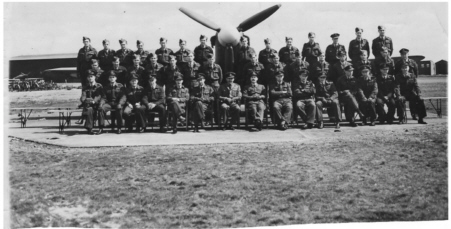
|
| "We were flying in battle formation from Brunton on the 29 November 1943 when Taffy Jones spun in off a steep turn into the W.A.A.F. site at
Milfield". Sgt A.V.Jones. is buried in Kirknewton curchyard. |
| During Ian`s course he fired 485 rounds of 20mm ammunition, air to air, with a best hit ratio of 8.1%, passing the course with an above average rating. |
| As with most training establishments, those students who made additional effort, and appeared at the flight line offices on the scrounge for extra flying, were often rewarded and Ian thought he had added five or six hours to his O.T.U. flying course total in this way. |
| Ian went on from 59 O.T.U. to No 1 Tactical Exercise Unit. (T.E.U.) Royal Air Force Tealing. Tayside Scotland. 63 O.T.U. Honiley. Rufforth. Holm Moor. Rical. Driffield. Marston Moor, mainly on fighter affiliation work,
flying Hurricane and Mustang aircraft. The fighter aircraft being presented to bomber aircraft as simulated target aircraft for their gunners. He then went on to No 3 T.E.U. Royal Air Force. Aston Down. Gloucestershire and conversion to Typhoon 1b and A flight of the same unit, working up to fighting ability and joining 182 Squadron to fight through Europe, eventually becoming one of the two oldest flying Flight Lieutenants in the Royal Air Force in the 1980`s, also in the 1970`s he taught H.R.H. The Prince of Wales to fly an Air Cadet glider. |

Total Commitment
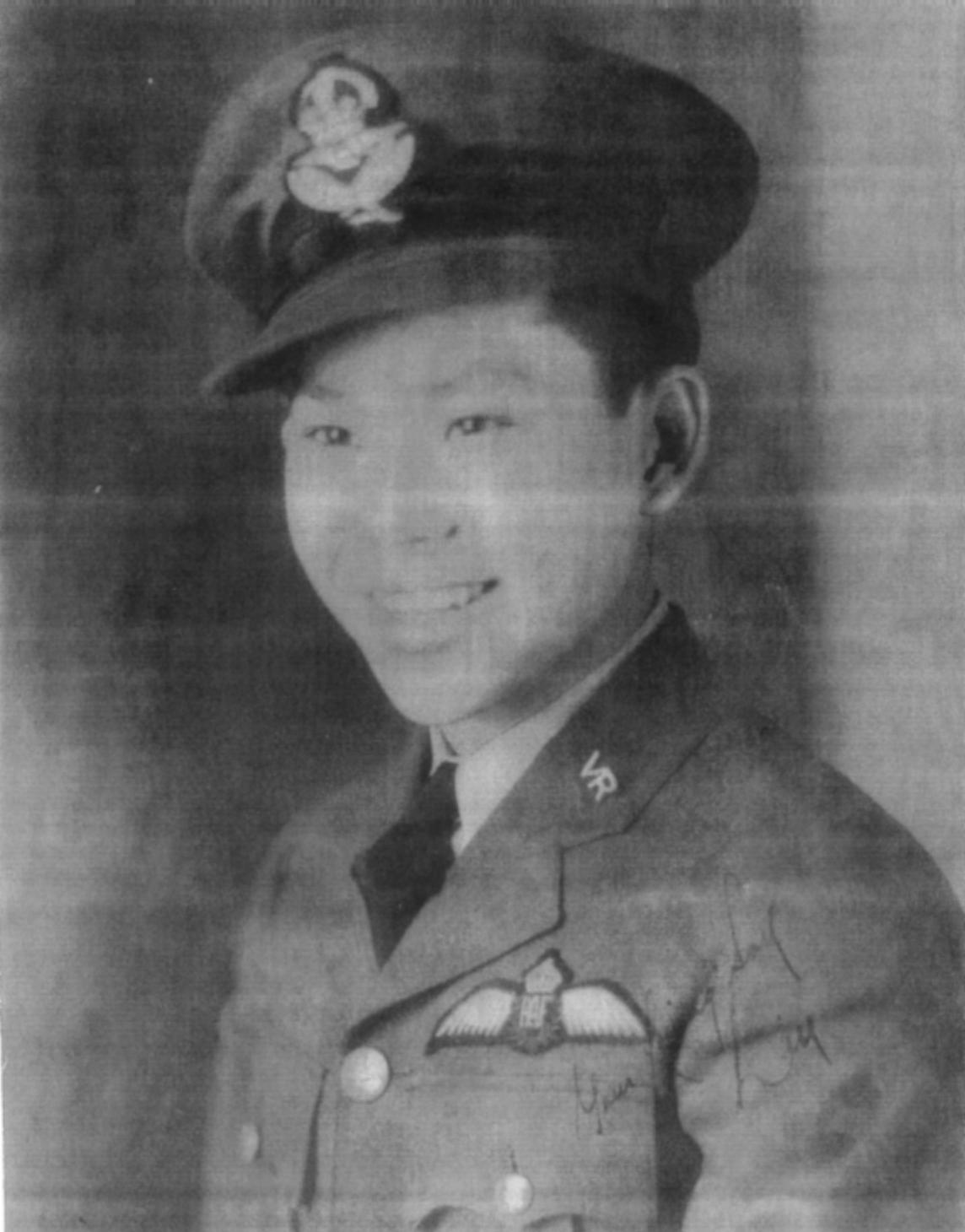
F/O Look-Yan, Previously mis-recorded in the booklet, "Milfield, not just an airfield……" as F/O Look-Yon. I have been permitted to use material in this update, that has been researched by Keith Davies and conducted on behalf of the Look-Yan family. A copy can also be found at the. memorial at Roseden Farm.Roddam. Wooler. Northumberland, the site of his fatal crash.
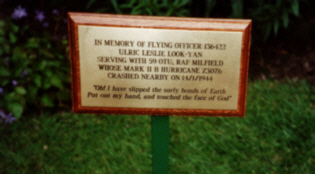
Ulric Leslie Look-Yan was born in 1922. in Port of Spain. Trinidad. British West Indies.
RECORCD OF SERVICE
of
Ulric Leslie Look-Yan. (136422)
Commenced training as a Pilot, under the Trinidad Air Training Scheme.
28.03.42. No 1 E.F.T.S. (Elementary Flying Training School ) Trinidad.
28.07.42. Enlisted in Canada as No 605481 L.A.C. (Leading Aircraftman).under the B.C.A.T.P.(British Commonwealth Air Training Plan) the renamed Empire Air Training Scheme, following the Ottawa agreement of 06 June 1942.
A.C.R.C.(Aircrew Reception Centre) Monkton. Nova Scotia. Canada.
No 41 S.F.T.S.(Service Flying Training School) Weyburn. Saskatchewan. Canada.
03. 12. 42. Discharged on appointment to commission Royal Air Force Volunteer Reserve
04. 12. 42. Commissioned as Pilot Officer, on probation General Duties Branch Royal Air Force Volunteer Reserve.
27. 01. 43. No 7 Personnel Receiving Centre.(Supernumerary Officer pending posting)
11. 05. 43. No 5 (P) A.F.U.* (Pilot Advanced Flying Unit) Royal Air Force Ternhill. Shropshire. Miles Masters
29. 06. 43. No2 G.P.E.U. * (Glider Pilot Exercise Unit) Royal Air Force Netheravon and
Royal Air Force Shrewton. Wiltshire. Flying, Qualified Army Glider Pilots on cross country flying and air experience flights, the glider pilots were on holding postings, until required for glider operations, and were keeping their hand in flying Tiger Moths.
30. 11. 43. No 59 O.T.U. Royal Air Force Milfield.
14. 01. 44. Killed in flying accident.
Remarks: This Officer made his first solo flight on 05.06.42. in the same month he had his first experience of cross country and night flying. In Nov 1942 he completed the course of training and on the 30 Nov 42 was awarded the Royal Air Force Pilots Badge. He was then strongly recommended for a commission, having done very well and having shown himself to be very keen, cheerful and sound throughout the whole period of initial training. In all he has done 475 hours 55 minutes flying hours.
My observations and suggestions: Once again it's a story of the Pilots flying logbook not being claimed by the family, as was their right, and of it being destroyed in the purge for space by Air Ministry in 1960. With his logbook, we would have been able to see the number of hours flown at the different units of his postings, up to the time of his death. As other students on these same courses, flew the hours indicated below, the assumption is, that his total flying hours can be divided up as follows:
E.F.T.S.
(Elementary Flying Training School) | Student Average Flying Hours per course: | 60 hours | No 1 E.F.T.S. (Empire Air Training School)E.A.T.S. Trinidad. |
E.F.T.S.
(advanced) | Student Average Flying Hours per course This course would have been conducted on the Harvard 11a 600-hp | 70 hours | B.C.A.T.P. 41E.F.T.S.Weyborn. Saskatchewan. Canada. |
A.F.T.S.*
(Advanced Flying Training School) | This course would normally be flying the Miles Master 715-hp, then converting to the Hurricane. At least 1,280-hp. | 80 hours | No 5 (P) A.F.T.S. Royal Air Force. Ternhill. Shropshire. (Miles Masters only)* |
No 2 G.P.E.U. *
(Glider Pilot Exercise Unit) | Flying Air Experience and Cross Country with glider pilots, 5 days per week for 5 months. Without an Instructor qualification or any instructing experience.. | 265 hours.55 minutes | All of this, large, total of flying hours would be logged as Pilot in Command, but the glider pilot would probably do most of the flying.* |
No 59 O.T.U.
Royal Air Force. Milfield. Northumberland. | Total Flying Hours at time of his fatal crash. | 475 hours 55 minutes | |
Why F/O Look-Yan had not been moved onto a unit to convert him to the Hurricane* before being posted to 59 O.T.U. Royal Air Force Milfield, The Typhoon O.T.U. is surprising, but then, at that time Typhoon`s were in short supply and he was able, after a few flights on Milfields Miles Masters, to show he was proficient enough to progress on to the Hurricane. On 04.12.43. His first flight on type, the Hurricane, was to end in a crash, with the aircraft failing to leave the runway and over running the public road, without injury to himself, further flights must have taken place in the next ten days but only the Crash Inquiry Report of his fatal crash and maybe, his log book would have indicated how many flights and of what type, took place in those ten days, One might think, Questions should have been asked after his first crash, as it does suggest that for some reason the aircraft got away from him at that time, maybe questions were asked and the decision was for him to continue his training on type.
The circumstances of his fatal crash, maybe available, Air 29, R.A.F. form No 540, the Station Operations Record book, may include the crash enquiry report. I am not aware of the time of day that the crash occurred, but the little that is known, is that at Eshott , the observer that recorded the weather on 14.01.44. at 0700hrs,1000hrs and at 1600 hrs gives a building high pressure system of 1011.2mb to 1019.6mb over the period, winds from WSW through W to SW W, 28 to 20 mph, gusty, through the period, cloud, 5 tenths, cloud base 2000 feet to 2500 feet, it is reported that: Hurricane Mk 11a Z3076, while engaged on a low level cross country, crashed at Roseden, 4 miles South East of Wooler, the Pilot, F/O Look-Yan 136522 killed.

I have included some of the family photographs of Ulric, known to his family as Lin, and passages from the letter to Mrs Maud Look-Yan by Group Captain James Addams. Officer Commanding. Royal Air Force Milfield after Ulric`s funeral at the R.A.F Regional Cemetary Stonefall Harrogate Yorkshire but not the telegram and letter of confirmation of his death. In G/C Addams words:
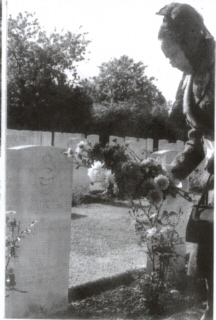
Maud Look-Yan at the graveside in 1972.
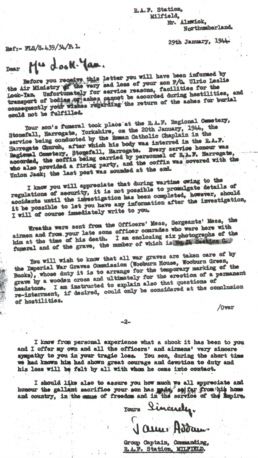
G/C Adams.
Total Commitment
Perhaps now is the time to mention some of the major milestones in the operational period of 59 O.T.U. 04 AUG 42 - 26 JAN 44, almost eighteen months. Over 100,000 flying hours, more than 1200 pilots trained to the requirements of front line fighter squadrons.
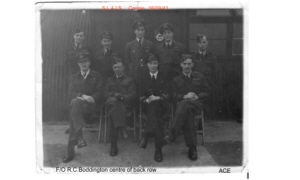
The ground attack aspects used the range set up at the beginning of 1943 at Goswick (now a golf course) and when first set up the simulated convoy included two Newcastle Corporation double decker buses, a furniture removal pantechnicon and an old steam lorry. But later the range became very sophisticated, with a large variety of targets both movable and fixed and with two, two-storey range observation towers to house the range officers who were in radio contact with the aircraft using the range.
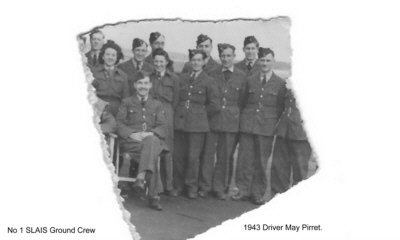
Wing Commander Denys Gillam, D.S.O., D.F.C., the foremost ground attack exponent in the Royal Air Force played a large part in the set up of this unit and completing his war with the awards of 2 D.S.0.'s, 2 D.F.C's and the A.F.C.

-TYPHOON 1B-
Sqd Ldr James `Ginger` Lacey, D.F.M. and bar, the highest scoring N.C.O. pilot during the Battle of Britain, was the Chief Flying Instructor for a
short while in early 1943, before going to Boscombe Down, Wiltshire, the Royal
Air Force armament and aircraft testing establishment as project officer on the
development of rocket projectiles to be carried by ground attack aircraft.
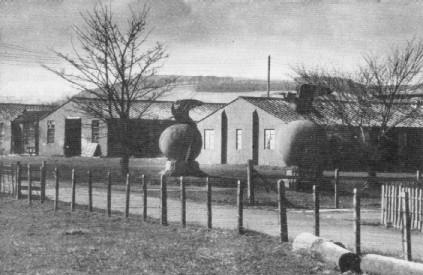
-THE GLOBES-
It was about June 1943 that the two globes mounted on plinths and surmounted by two eagles were built. William Brodie, farmer and owner of the land upon which the airfield was built told me in 1974 of how they came to be built. An Italian Prisoner-of-War allocated to work upon his farm was a craftsman in masonry and understanding the International make up of the courses suggested the idea of the globes, which, when viewed fifty years later, are in very good order. That is, one is
in good order, with the continents in relief upon the globe and the surmounting eagle
in balance with the whole, whereas, the second globe never had the continents in relief and the eagle stands upon two short legs which imbalance the look of it. The reason being, the Italian prisoner was assisted by an airman to make first the two plinths and then to help with making the globes, one being completed before the prisoner was removed. The airman having gained some expertise, then completed the second globe and its eagle. One can only assume that someone had complained of an airman helping a prisoner-of-war to do a job neither were supposed to be doing but both provide
a unique memorial to the period and task that was Milfield.
On 05 July '43 Flt/Lt Smith and a party from 9 group, arrived to investigate the reason for the,larger, than normal, number of aircraft accidents on final approach to runway 24. Not much was known of wind shear/shadow or curl over at that time. Later in Milfield history it was well understood and the objects of its cause used to advantage. But in 1943, the pupils although well trained and flying the approach as trained. which allowed margin for the wind speed reducing with a decrease in altitude, were in some conditions, flying down the approach and suddenly into an area of greatly reduced windspeed, at a height which did not allow them to recover, even if they had known of the possibility.
During the three and a half years of operations at Milfield 51 pilots were killed or died as a result of injuries received
in flying accidents - an average of one per month - with between 10-15 accidents per month. A list of those who died in flying accidents while in training at Milfield is at the end of this history.
17 Sept 1943, B17, Flying Fortress, F230023 crashed 3 miles East of Seahouses. Eight of the crew were rescued, I of whom was injured, 2 drowned. Major Forrest flew a B 17 from Knettishall, Suffolk and landed at Milfield to take back the survivors. It was decided that runway 24 was too short for the B I 7 to take off, so the contractors on site, one of whom was Butt Morton, of Morton's Motor Company, Akeld, removed the hedges of the Wooler to Milfield road and extended runway 24 across the road and towards dispersed site No.8 with sheets of pierced steel planking. In the event, the B17 took off with room to spare, the hedge is still missing!
59 O.T. U. had become known as the Typhoon O.T.U. except for a period of three weeks at the end of June when, the supply of that aircraft from HAWKERS, the makers at Langley, had stopped due to a strike by the workers making them. The course affected had to complete on the Hurricane and to convert to the Typhoon at a later date.
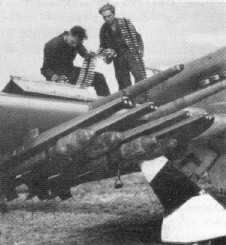
-TYPHOON RE-ARMING-
Despite the snows of both 1942 and 1943, when all station personnel who could be spared were used to clear the main runway of snow, resulting in two walls of snow to some four feet bordering the runway, the good weather factor which normally pertains at Milfield was of paramount value to the output of the O.T.U.
The closing down of 59 O.T.U. on 26 JAN 1944 was attended by Air Vice Marshall D.F. Stevenson, Air Officer Commanding 9 Group who gave an address thanking the unit for its fine achievement.
The fact that half of those trained to fly ground attack with the Typhoon at Milfield would not survive the invasion and early advances into France was not known then!
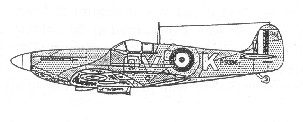
-SPITFIRE 1-












